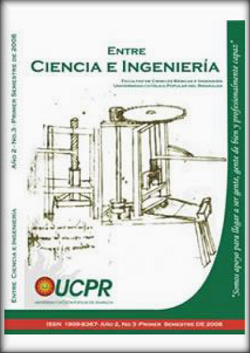(HMIPv6-BI) Propuesta de modificación al protocolo HMIPv6 para mejorar el ancho de banda en el canal radio
Keywords:
Hierarchical Mobile IPv6, , handover (transfer), tunnelingAbstract
In this article the obtained results of the analysis carried out to a modification proposal to theHierarchical Mobile IPv6 (HMIPv6) protocol named HMIPv6-BI are exposed. The goal ofHMIPv6-BI is to reduce the bandwidth usage of the radio link between the access router (AR)and the mobile node (MN). In HMIPv6 a tunnel is established between the mobility anchorpoint (MAP) and the MN, causing that the headers of the tunnel travel over the wirelessinterface and a major usage of the channel is required. HMIPv6-BI improves this situation, theanalysis of HMIPv6-BI shows favorable results, when it is compared to the standard approachHMIPv6, by analytic models and NS-2 simulations.
References
Becerra, Sánchez, L. Y. (2008). Evaluación de una Propuesta de Modificación al Protocolo Hierarchical Mobile IPv6 (HMIPv6) en la tunelización (tunneling) de información. Tesis de Maestría. Universidad Pontificia Bolivariana- Medellín, 113p.
Castellucia, C. & Soliman, H. (2005). Hierarchical Mobile IPv6 Mobility Management (HMIPv6). IETF, RFC4140, 18 p.
Chan Lee, Y., Jumari, K. & Ismail, M. (2005). An Analysis of the Handover for Hierarchical Mobile IPv6. IEEE 7th Malaysia International Conference on Communications.
Conta A. & Deering, S. (1998). Generic Packet Tunneling in IPv6 Specification. IETF, RFC2473, 36 p.
Deering S. & Hiden, R. (1998). Internet Protocol Version 6 (IPv6) Specification. IETF, RFC2460, 40 p.
Hanh, R., Soong, H. & Ryu, J. (2007). A Modification for Fast Handover in Hierarchical Mobile IPv6. Advanced Communication Technology, The 9th International Conference, 4 p.
Hardekopf, B. & Jasleen, K. (2002). Impact of Network Protocols on Programmable Router Architectures. Thesis Report, 28p.
Helmy, A. (2000). A Multicast-based Protocol for IP Mobility Support. ACM SIGCOMM 2nd International Workshop on Networked Group Communications, 9 p.
Helmy, A., Jassemuddin, M. & Bhaskara G. (2004). “Multicast-based Mobility: A Novel Architecture for Efficient Micro-Mobility.” IEEE Journal on Selected Areas in Communications (JSAC), Special Issue on All-IP Wireless Networks, 13 p.
Intel. (2001). Intel IXP1200 Network Processor Family. Manual, 272p.
kaur, J. (2002). Scalable Network Architectures for Providing Peer-flow Service Guarantees. PhD thesis, Department of Computer Sciences, University of Texas at Austin.
Koodli, R. (2005). Fast Handovers for Mobile IPv6. IETF, RFC4068, 33 p.
Lei, L. (2005). Fast Handover Using Explicit Multicast for IPv6-based Wireless LAN Networks. Thesis, Department of Informatics, School of Multidisciplinary Sciences, the Graduate University for Advanced Studies (SOKENDAI), 126 p.
Padilla, J. & Paradells, J. (2007). Intserv6: An approach to support QoS over IPv6 wired and wireless networks. EUROPEAN TRANSACTIONS ON TELECOMUNICATIONS, 18 p.
Padilla, J., Paradells, J., Huertas, Mónica & Hesselbach, X. (2005). IntServ6: An Approach to Support QoS over IPv6 Networks. Proceedings of the 10th IEEE Symposium on Computers and Communications (ISCC 2005) IEEE, 6p.
Padilla, J.; Paradells, J. & Rodriguez A. (2006).Supporting QoS over IPv6 wireles networks with Intserv6. The 17th International Symposium on Personal, Indoor and Mobile Radio Communications (PIMRC06), 5p.
Perkins, C. & Jhonson, D. (2004). Mobility Support IPv6. IETF, RFC3775, 100p.
Taewan, Y., Sangheon, P. & Yanghee, C. (2003).Robust Hierarchical Mobile IPv6 (RHMIPv6). Brain Korea 21 project of Ministry of Education and National Research Laboratory project of Ministry of Science and Technology, 5 p.
Walhlisch, M. & Schmidt, T. (2003).Seamless Multicast Handover in a Hierarchical Mobile IPv6 Enviroment (M-HMIPv6). draft-schmidt-waehlisch-mhmipv6-00.txt,








 Revista Entre Ciencia e Ingeniería
Revista Entre Ciencia e Ingeniería .png) entrecei@ucp.edu.co
entrecei@ucp.edu.co.png) ISSN (Impreso) 1909-8367 - ISSN (En Línea) 2539-4169
ISSN (Impreso) 1909-8367 - ISSN (En Línea) 2539-4169 Attribution-NonCommercial 4.0 International (CC By-NC 4.0)
Attribution-NonCommercial 4.0 International (CC By-NC 4.0)
.png) Carrera 21 No. 49-95 Av. de las Américas, Pereira, Risaralda, Colombia
Carrera 21 No. 49-95 Av. de las Américas, Pereira, Risaralda, Colombia